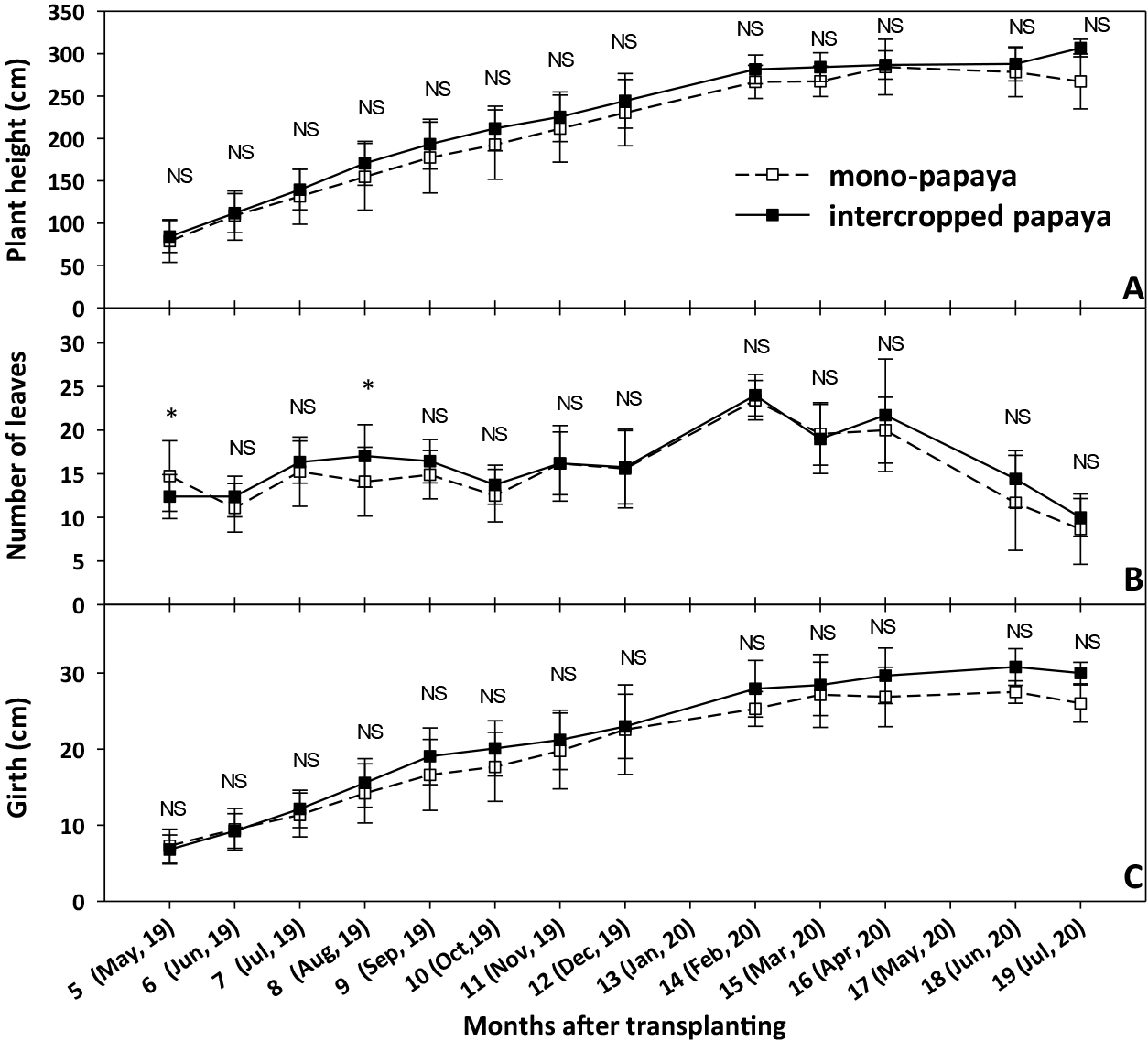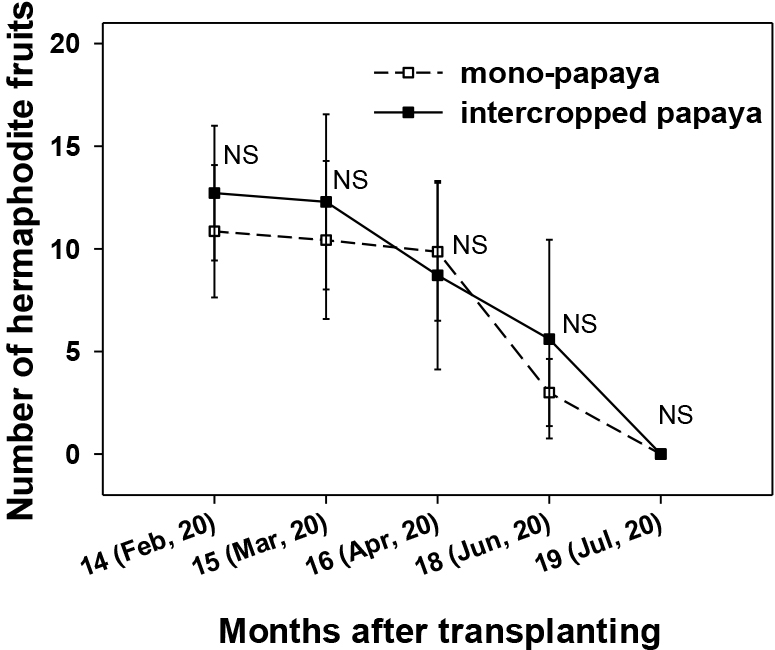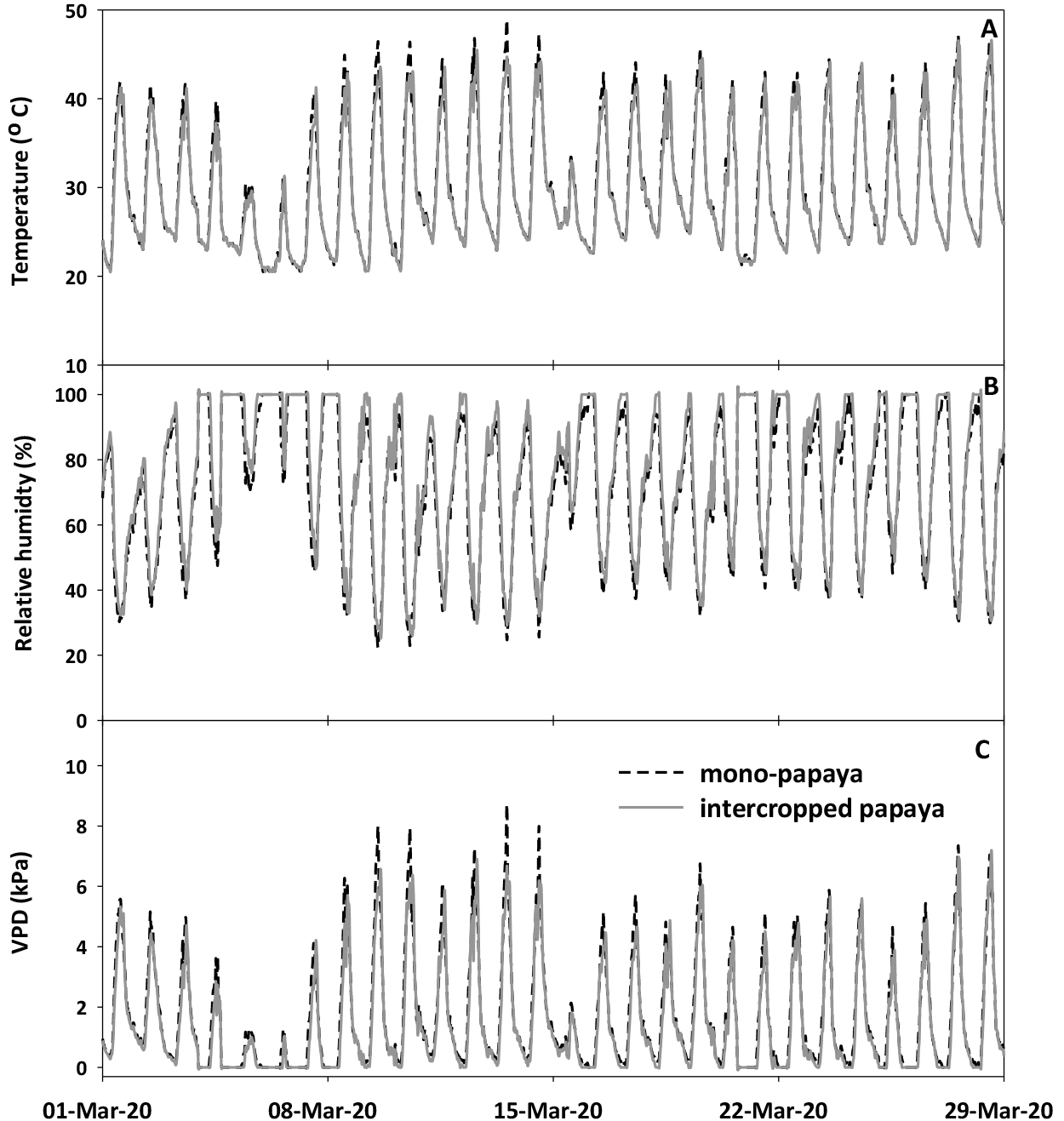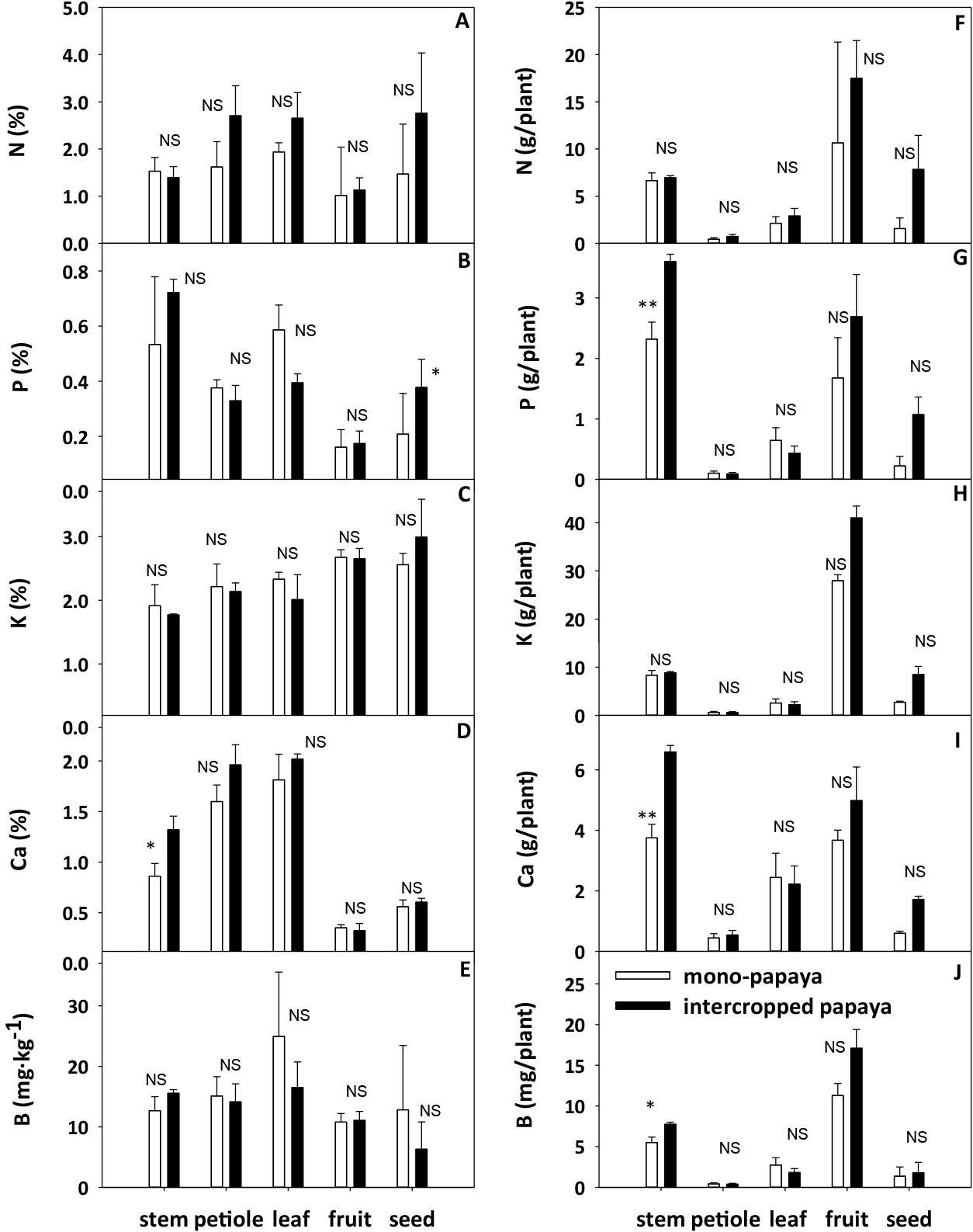2023 年 92 巻 2 号 p. 142-150
2023 年 92 巻 2 号 p. 142-150
Papaya cultivators in northeast Thailand deal with dry conditions that dramatically affect growth, yield, and fruit quality. The use of intercropping fruit crops, especially banana, should improve papaya production. This study evaluated intercropping papaya and banana in terms of papaya growth, fruit quality, and nutrient content. Experiments were conducted at the Fruit Tree Experimental Field, Faculty of Agriculture, Khon Kaen University between January 2019 and July 2020. The mono-papaya and intercropped papaya with banana used 3 × 2 m spacing, and the intercropped papaya used 1 row of banana with 3 rows of papaya. Plant growth was analyzed between the 5th and 19th month post-transplantation, while fruit yield and nutrient status were evaluated between the 14th and 19th month after transplantation. Plant height, number of leaves, and girth were not different between mono- and intercropped papaya. All plant growth patterns were sigmoidal, reaching stable growth rates between the 15th and 19th month after transplantation. Fruit numbers were not significantly different, but banana-intercropping with papaya increased papaya yield through fruit length and pulp thickness. Nutrient levels in all plant parts were not significantly different. In addition, nutrient analysis identified that papaya fruit extracted N, K, and B at higher levels than other parts, while P and Ca were the highest removed by the stem.
Papaya (Carica papaya L.) is an important economic crop in Thailand for export and domestic consumption. The cycle of papaya production in Thailand is around 1.5–2.0 years from transplantation to final crop harvest. The first 4–6 months is a vegetative growth phase, with fruit harvesting occurring 8–24 months after transplantation. Climate change induced drought is impacting crop production, particularly in the northeast region of Thailand, where the dramatically hot and dry conditions reduce fruit yield and quality. Thus, papaya production requires methods to minimize damage caused by these drought conditions.
Intercropping is reported to improve crop productivity, weed control, and nutrient availability (Aiyelaagbe and Jolaoso, 1992; Dai et al., 2019; Ofosu-Anim and Limbani, 2007; Olasantan, 2001; Olubode et al., 2011, 2012; Singh et al., 2016; Zhang and Li, 2003; Zhu et al., 2022). Moreover, intercropping species can additionally increase soil moisture, cool air, reduce wind speed, and modulate soil temperature, thus improving environmental conditions, increasing growth and yield (Arunachalam et al., 2021; Ossom, 2003; Vincent et al., 2017). An excellent example of improved conditions due to intercropping is the reduction of ringspot virus in papaya (Sharma et al., 2010; Vincent et al., 2017). However, all current papaya intercropping reports focus on intercropping between papaya and vegetable crops, such as cucumber (Olubode, 2019; Olubode et al., 2011, 2012) and okra (Olubode et al., 2009).
On the other hand, there is little research on intercropping with large-leafed plants (Belel et al., 2014). Papaya is a broad-leaf plant, while banana is a group of Gramineae type with similar height levels. Currently, there are few reports available on intercropping between plants of similar or slightly greater heights. Banana is also an economic staple in Thailand with valuable products including leaves for food packaging applications and fruit for consumption. Bananas used as cash crops for intercropping with papayas may benefit the environment and increase farmers’ income. Broad-leafed plants can improve environmental conditions by creating optimal climate condition for papaya plantations. By minimizing variations in temperature and the vapor pressure deficit (VPD), carbohydrate synthesis and growth are improved (Campostrini and Glenn, 2007). Potential competition between two large broad-leafed intercropping plants in terms of growth, nutrient status, and production also requires evaluation. Therefore, this research examined the intercropping of papaya with banana evaluating growth, papaya yield, and nutrient composition changes in the leaves, petiole, stem, fruit, and seeds of papaya.
The comparison of mono-papaya and intercropped papaya with banana was conducted between January 2019 and July 2020 at the experimental plantation of the Fruit Tree Division, Faculty of Agriculture, Khon Kaen University. The field is located 182 m above sea level (16°27'52.5"N 102°48'25.1"E) with 1,200 mm of annual rainfall and an average temperature of 26.6°C. The soil is sandy soil with the following properties at a depth of 0–30 cm; pH 5.6–5.7, 1.3–1.5% soil organic matter, 15–30 mg·kg−1 available P, 186–313 mg·kg−1 K, and 26–34 mg·kg−1 Ca. Mono-papaya and intercropped papaya spacing was 3 × 2 m, and the intercropped papaya used 1 row of banana with 3 rows of papaya (Fig. 1).

Illustration of plant spacing for mono-papaya (A) and intercropped papaya with banana (B). At the mature stage, the papaya plant was 2.16 ± 0.36 m in width and 2.82 ± 0.40 m in height, while the banana plant was 3.86 ± 0.38 m in width and 3.29 ± 0.15 m in height.
The 2-month-old ‘Khaek Dam’ papaya seedlings were transplanted using three plants per hole. One hermaphrodite plant was selected upon flowering (4–6 months after transplanting), and the two other plants removed. The fertilizer applied was a 1:1 mixture of urea and 15-15-15 formula, with 50 g/plant·month−1. For the intercropped papaya-banana plot, the banana clone was Musa sp ‘ABB group’ or Namwa, and 2-month-old suckers were transplanted simultaneously with papaya.
Growth evaluationTen plants were selected in each planting system for growth evaluation. Monthly growth measurements were performed for the period between the 5th and 19th month after transplantation. The height, girth at 15 cm above ground, leaf numbers, and hermaphrodite fruits were collected. Hermaphrodite fruits were included in counting when the fruit length was greater than 10 cm.
Fruit quality evaluationFruit quality evaluation was conducted 14–18 months after papaya transplantation. From each plot 5 plants were selected. Mature fruits with 5% yellow peel were harvested. The sampled fruits were then left at room temperature until the peel reached 80% yellow coloring. These fruits were evaluated for characteristics such as width, length, weight, volume, seed weight, and pulp thickness. After, peel and pulp color were measured by a color meter (MSEZ-4500L; HunterLab, Reston, VA, USA), then total soluble solids (TSS) measured by a refractometer (PAL-1; Atago Co. Ltd., Tokyo, Japan), and the pulp titratable acidity (TA) according to A.O.A.C. (1990).
Plant nutrients analysisNutrients in the leaves, petiole, stem, and fruit for each plot were analyzed. The 5th–7th positions of leaves and petiole were sampled each month from the 15th to 19th month post-transplantation. Subsequently, the leaf and petiole were separated. Plant samples were then dried in a hot air oven at 65°C for 72 hours. The physiologically mature fruits were also collected during this period when peels were around 5% yellow. These fruits were used to evaluate fruit quality. Samples were dried in a hot air oven for between 3–7 days until completely dry. The fresh weight and dry weight were recorded. All samples were analyzed for nitrogen (N), phosphorus (P), potassium (K), calcium (Ca), and boron (B) concentrations. The N, P, K, and Ca samples were digested by the wet acid method according to Attanandana et al. (1994) and Mills and Jones (1996), while B was digested by dry ashing in a muffle furnace at 550°C. Colorimetric N and P analyses were used (Attanandana et al., 1994; Baethgen and Alley, 1989; Kayaphad et al., 2021; Suwanwong, 2004). The K and Ca levels were analyzed using a flame photometer (Attanandana et al., 1994), while B was determined colorimetrically using azomethine-H (Attanandana et al., 1994).
Climate evaluation in the example periodTemperature and relative humidity were recorded every 30 minutes during the dry period from February to March 2020 by the Hobo Pro V2 data logger (Onset Computer Corporation, Bourne, MA, USA). Vapor pressure deficits (VPD) were then calculated according to Allen et al. (1998).
Statistic evaluationComparisons of means were analyzed using Statistix 10 (1985–2013 Analytical Software, FL, USA). The means of growth, yield, fruit number, and nutrient status were compared using t-test analysis, while fruit qualities were analyzed using Two-way ANOVA with planting systems and the two harvesting periods at 14–15 months after transplantation (February–March 2020) and 17–18 months after transplantation (May–June 2020).
Plant height, number of leaves, and girth at 15 cm above ground of the mono-papaya and intercropped papaya systems were evaluated monthly from the 5th to 19th months after transplantation. Analysis showed no significant difference in plant height, number of leaves, and girth in all periods (Fig. 2). Shading due to banana had no effect upon growth, indicating that 3 m row spacing (Fig. 1) was sufficiently wide for intercropping papaya and banana. This is important as plants generally response to poor light levels by increasing height. Papaya intercropped with okra and cucumber was found to significantly decrease plant height and canopy diameter (Olubode et al., 2012). However, shade from intercropped plants benefits soil water reserves, erosion, and weed control (Asten et al., 2011; Beer, 1987; Vincent et al., 2017). For the 15th to 19th months after transplantation, papaya attained a stable growth rate in terms of height (Fig. 2A) and girth (Fig. 2C). Also, leaf numbers were reduced (Fig. 2B). This stage (1.5 years after planting) is usually the last for papaya, especially in Thailand, with replanting required. In addition, at 19 months of the investigation on growth, plant height, and papaya girth increase reflecting the sigmoid growth curve with the papaya plant expressing stable growth in the 15th–19th months after transplanting.

Comparison between mono-papaya and intercropped papaya with banana, showing plant height (A), number of leaves (B), and girth at 15 cm above the ground (C), for ‘Khaek Dam’ papaya 5–19 months after transplantation. The vertical error bar indicates standard deviation (n = 10). NS and * indicate non-significant difference and significant difference at a level of 0.05, respectively. Means were compared for significant difference by t-test.
Evaluation of the number of hermaphrodite fruits, as shown in Figure 3, revealed no significant difference in fruit number. It also indicated that flowering and sex ratios were not affected by intercropping with bananas. Flowering is a general plant response relating to plant growth (Olubode et al., 2012). Fruit yield and quality were evaluated in the period between 14th and 18th month after transplanting. The total yield for the intercropped papaya increased 1.57 times that of the mono-papaya system, with no significant difference in the number of fruits (Table 1). Fruit qualities (Table 2) of the mono-papaya and intercropped papaya are listed for two fruit harvesting periods: 1) 14–15 months after transplantation (February–March 2020) and 2) 17–18 months after transplantation (May–June 2020). When considering fruit growth, the papaya development period is approximately 150 days after flowering (Salinas et al., 2019). For the first harvesting period, the fruit development stage ranged between October 2019 to January 2020. In Thailand, this is the end of the rainy season to the end of the cold season. In the second harvesting period, the fruit development stage ranged between January and April 2020; the driest and hottest season in Thailand.

Comparison of mono-papaya and intercropped papaya with banana, showing the number of hermaphrodite fruits for ‘Khaek Dam’ papaya 5–19 months after transplantation. The vertical error bar indicates standard deviation (n = 10). NS indicates non-significant difference. Means were compared for significant difference by t-test.

Mono-papaya and intercropped papaya with banana, showing yield and number of fruits ‘Khak Dam’ papaya 14–18 months after transplanting.

Mono-papaya and intercropped papaya with banana, showing fruit qualities of ‘Khak Dam’ papaya 14–15 months after transplantation (February–March 2020) and 17–18 months after transplantation (May–June 2020).
The two-way ANOVA in Table 2 show that intercropped papaya produced higher fruit weight, fruit length, and pulp thickness than in the mono-papaya system, but the intercropped papaya system was lower in TSS than the mono-papaya system. However, differences in fruit qualities between the two systems were insignificant for TA, firmness, as well as peel and pulp color. This indicates that intercropping papaya does not affect the eating and sensory qualities. Additionally, the comparison of two harvesting periods on fruit characteristics showed that the harvesting period at 17–18 months after transplanting had lower seed weight per fruit (P < 0.05) and pulp thickness (P < 0.05) than the harvesting period at 14–15 months after transplanting (Table 2). The high temperature of Thailand during the March to April 2020 second harvesting period is expected to negatively affect the fertilization process.
Moreover, a highly positive correlation was observed between fruit length and pulp thickness with fruit weight (data not shown). This indicated that intercropping increased fruit size by increasing fruit length and pulp thickness. This may be caused by the improved climate environment around the papaya due to intercropping with banana. The climate data for the extremely dry March 2020 period showed lower temperatures, higher relative humidity, and lower VPD during critical daytime periods (around midday) for intercropped papaya compared with mono-papaya (Fig. 4). The midday temperature and VPD for the intercropped plot were reduced by 1–2°C and 10–15% compared to the mono-papaya plot. Similarly, previous work on sunn hemp and papaya intercropping demonstrated positive changes in the immediate climate environment (Vincent et al., 2017).

The diurnal temperature (A), relative humidity (B), and vapor pressure deficit (VPD, C) of mono-papaya and intercropped papaya with banana in March 2020.
The optimum growing temperature range for papaya is generally between 21°C and 33°C (Knight, 1980), with temperatures greater than this reducing photosynthesis. Air temperature increases also directly increases VPD, which influences stomata conductance, reducing transpiration (Isarangkool Na Ayutthaya et al., 2018; Meinzer et al., 1997), and subsequently photosynthesis (Campostrini and Glenn, 2007). Papaya is strongly affected by VPD. For environments with between 3.5 to 4.5 kPa VPD, stomata tend to close with a net 40–50% reduction in photosynthesis compared with environments with a VPD of 1.0 to 1.5 kPa (El-Sharkawy et al., 1985). In our case, for papaya planted in the driest area, Khon Kaen province where temperatures reached more than 40°C in summer (Fig. 4), the carbohydrate synthesis is expected to be negatively affected. Papaya growth rates are expected to be lower, given the less than optimal high temperatures. Additionally, intercropping can increase soil moisture (Olasantan et al., 1996), increase soil shading (Arunachalam et al., 2021), and improve root growth (Ramirez-Garcia et al., 2015). Moreover, banana intercropping regulates wind speed, reducing the impact of strong wind on stomata conductance and photosynthesis (Campostrini and Glenn, 2007; Clemente and Marler, 2001). Therefore, fruit growth may be improved through improvements in climate and soil environment.
Nutrient changes in leaf compositionsThe N, P, K, Ca, and B in leaves and petiole were investigated between the 15th to 19th months after transplantation (Fig. 5). Generally, there were no significant differences in nutrient levels between both leaf and petiole (Fig. 5). The comparison of N, P, K, Ca, and B in the leaves with general standard values (Mills and Jones 1996; Vos and Cho, 2016) suggested that N and P were slightly higher than standard. The standard ranges for N and P were 1.01–2.50% and 0.22–0.40%, respectively. The K, Ca, and B in our experiment reflected the standard ranges.

Comparison of mono-papaya and intercropped papaya with banana, showing nutrient levels including nitrogen (A, B), phosphorus (C, D), potassium (E, F), calcium (G, H), and boron (I, J) in the leaves (left) and petiole (right) of papaya ‘Khaek Dam’ 14–19 months after transplantation. The vertical error bar indicates standard deviation (n = 5). NS and * indicate non-significant difference and significant difference at a level of 0.05, respectively. Means were compared for significant difference by t-test.
Nutrients in the stem, petiole, leaves, fruit, and seeds of mono-papaya and intercropped papaya were also investigated in the final stage, at the 19th month. These tests revealed no significant differences in nutrient levels for all plant parts, both in nutrient concentration (Fig. 6A–E) and nutrient content (Fig. 6F–J). However, the P (Fig. 6G), Ca (Fig. 6I), and B (Fig. 6J) contents of the intercropped papaya stem were higher than mono-papaya. Possibly due to the slightly larger stem of the intercropped papaya than the mono-papaya. This evidence indicates that intercropping papaya and banana did not affect plant growth or tissue nutrients. In terms of nutrient removal from each plant part, the fruit was observed to be the strongest N, K, and B sink, while P and Ca most removed by the stem. The fruits removed nutrients by 11–18 g of N, 1.7–2.6 g of P, 29–43 g of K, 3.8–5.1 g of Ca, and 14–18 mg of B per plant.

Comparison of mono-papaya and intercropped papaya with banana, showing nutrient concentration (left) and nutrient content (right) in plant sections, including stem, petiole, leaves, fruit, and seeds of papaya ‘Khaek Dam’ at the 19th month after transplantation. Nitrogen, phosphorus, potassium, calcium, and boron levels are expressed in Figures A and F, B and G, C and H, D and I, and E and J, respectively. Vertical error bars indicate standard deviation (n = 5). NS, *, and ** indicate non-significant difference, significant difference at a level of 0.05, and significant difference at a level of 0.01, respectively. Means were compared for significant difference by t-test.
This work investigated intercropping papaya and banana in the arid area of Thailand, Khon Kaen province. In this area, the annual rainfall is less than 1,200 mm (Ogura et al., 2007) and the temperature in the summer season is higher than 40°C (Senapeng and Busababodhin, 2017), unsuitable conditions for papaya. The main finding indicated that banana had no negative effect on papaya growth and nutrient status. This may be due to the optimal spacing of 3 × 2 m, with 1 row of banana and 3 rows of papaya. As there was minimal competition between the papaya and banana for nutrients, the intercropped papaya did not suffer from reduced growth. In fruit evaluation, intercropping increased yield per plant by increased pulp thickness, as the intercropping system positively changed the climate environment. This positively affected water regulation through the stomata, influencing carbohydrate synthesis efficiency. It is also possible that the improved climate affected pollination and fertilization, as the intercropping system yielded more seeds than mono-papaya (Table 2). However, to confirm the value of intercropping papaya, further analysis on fruit growth, the soil and plant water status, and photosynthesis efficiency are recommended. Finally, the economic benefits and costs of operation are also necessary to consider.
ConclusionsThe comparison of mono-papaya growth and intercropped papaya with banana in a 3 × 2 m spacing revealed that intercropping did not negatively impact plant growth and nutrient status. However, intercropping did increased yield through increased pulp thickness. This may be due to an improved climate for the intercropped papaya due to the banana plants, which lowered temperature, raised relative humidity, and lowered vapor pressure deficit at midday. Thus, papaya crop production in areas with adverse conditions including high temperature and low relative humidity are improved by intercropping with bananas.
We wish to gratefully acknowledge the support of the Agricultural Research Development Agency (Public Organization), Thailand. Also, we would like to thank the Research Group on ‘Development of research on rubber tree and potential fruit crop in northeastern’ and Khon Kaen University for their support.